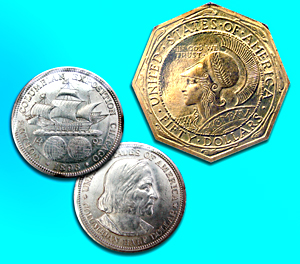Our Original Commemoratives, 1892-1954
|
"Making Cents"
The Signal
Saturday, March 25, 2006
| M |
The Columbian half dollar was the same size and weight of the regular half dollar and was issued in both 1892 and 1893. They were sold by the fair's sponsors at $1 each, with the profit going to cover exposition costs.
More than 2.4 million were minted, and most were never sold. The fair's sponsors eventually put them into circulation atface value
In 1893 the Board of Lady Managers had a commemorative quarter issued featuring Queen Isabella, who helped finance Columbus' 1492 expedition to the New World. Only 24,000 were minted, and they were sold for $1 at the fair. Aside from those given to VIPs, the rest sold out.
It wasn't until 1900 when the next commemorative coins was issued: the Lafayette silver dollar honoring the Marquis de Lafayette, who helped the colonists defeat the British. Only 36,000 were minted and offered for sale at $2. The issue was sold out. The funds from the sale — the $1 mark-up over the face value — went for the Lafayette Memorial Committee's work.
After that, 47 different silver half dollars were issued between 1918 and 1954. Some issues, such as those for the Oregon Trail and the Booker T. Washington, were minted over a several-year period.
In mint condition, all of these issues are valuable, and some are even "rare," worth thousands of dollars.
The diverse subjects commemorated include: York County, Maine tercentenary; the Battle of Gettysburg; Illinois centennial; Rhode Island tercentenary, Old Spanish Trail, Panama Pacific Exposition and many others. A complete set of silver coins consists of 144 pieces.
As a result of the glut of commemoratives issued during the 1930s — often for minor historical matters of dubious significance — Congress put a clamp on future commemoratives for a while. The only post-World War II issues were in 1946 for Iowa's centennial and the Booker T. Washington and Washington-Carver series from 1946 to 1954. It was not until 1982 when the first post-1954 commemorative was issued, marking the 250th anniversary of the birth of George Washington.
During this period (1892-1954), several gold commemoratives were also issued. The first, a pair of $1 gold coins, was issued in 1903 to honor the Louisiana Purchase; another pair of gold $1 coins in 1904 and 1905 honored the expedition of Lewis and Clark.
In 1916 and 1917, a $1 gold coin as issued to honor William McKinley. In 1915, four gold coins were issued for the Panama Pacific Exposition — $1 gold, $2.50 gold and a pair of $50 gold coins — the only $50 gold coins authorized by the U.S. Mint. These are quite rare; original sets containing all of the gold coins and the half dollar can bring close to $1 million.
In 1926, a gold $2.50 coin was issued in honor of the 150th anniversary of American independence. At a mintage of 46,000, this is the most common of the gold commemorative coins.
Since 1982, a whole new series of commemorative coins has come out annually, often in denominations of 50 cents, $1 and even $5 gold. For a complete list of these issues, refer to the annual issue of "A Guide Book of United States Coins," aka the "Red Book," or for more specific information, there are several books on the subject by Anthony Swiatek, Q. David Bowers and Arlie R. Slabaugh.
Dr. Sol Taylor of Sherman Oaks is president of the Society of Lincoln Cent Collectors and author of The Standard Guide to the Lincoln Cent. Click here for ordering information.
©2006, THE SIGNAL · ALL RIGHTS RESERVED.
